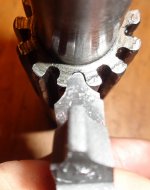Rudd
Stainless
- Joined
- Jul 30, 2003
- Location
- savannah, jaw-ja
I am making a pinion for the feed on an antique DP. It is 1.25" OD, 13 teeth. So, I got a No. 8 12 pitch cutter. It cuts teeth much too wide to match the original. I'm thinking these are not standard teeth. Did they use a lower cutter number - i.e., a 6, a 7? A cutter of a different DP than standard?
Would a gear pitch gauge gauge help me sort this out? It looks like it would only address the DP number.
Thanks
Would a gear pitch gauge gauge help me sort this out? It looks like it would only address the DP number.
Thanks








